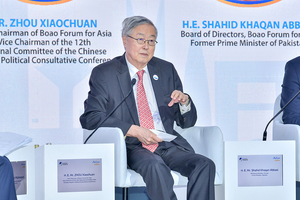Weekend Long Read: The Role of Pricing in China’s Changing Power Market
Listen to the full version

Editor’s note: Below is a speech given by Zhou Xiaochuan, vice chairman of the Boao Forum for Asia and a former governor of the People’s Bank of China at a forum organized by the China Electricity Council on June 12.
Since the launch of the new round of power system reform in 2015, China’s power market construction has rapidly advanced. In recent years, a series of reform initiatives by the Communist Party and the State Council have further accelerated this progress.

Unlock exclusive discounts with a Caixin group subscription — ideal for teams and organizations.
Subscribe to both Caixin Global and The Wall Street Journal — for the price of one.
- DIGEST HUB
- China's power sector, responsible for 45% of its carbon emissions, is undergoing rapid reform since 2015, integrating new-energy systems and optimizing the "source-grid-load-storage" system.
- Effective electricity pricing and carbon pricing mechanisms are critical for emission reductions; tiered and dynamic pricing models, incorporating time-of-use and real-time rates, are essential.
- Efficient resource allocation and substantial investment, primarily from private capital, are crucial for addressing climate change, advancing energy transition, and optimizing new technologies.
Zhou Xiaochuan, vice chairman of the Boao Forum for Asia and former governor of the People’s Bank of China, delivered a speech on the progress and challenges of China’s power system reform at the China Electricity Council forum on June 12. He highlighted the advancements made since the 2015 power system reform, driven by various initiatives from the Communist Party and the State Council [para. 1][para. 2].
The power sector is the largest carbon emitter globally and in China, producing about 45% of the country's total emissions, compared to 40% globally. Achieving net zero in this sector could resolve nearly half of the carbon reduction issue [para. 3]. Additionally, electrification, such as switching to electric vehicles, is pivotal for addressing 70-80% of future carbon emissions, making the power sector integral to emission reduction efforts [para. 4].
China has made significant strides in power equipment, grid, storage, and auxiliary services, supporting both domestic development and global climate change mitigation, particularly through infrastructure projects like the Belt and Road Initiative [para. 8]. The introduction of new-energy sources like wind, solar, and power storage into the system requires a responsive pricing mechanism to handle their intermittent nature. Effective pricing mechanisms are critical for the demand side to adapt and respond to supply capabilities [para. 18].
China has historically kept residential electricity prices low to protect low-income households, resulting in cross-subsidies from industrial electricity prices. This approach often led to unsustainable economic distortions [para. 24][para. 25]. The future determination of electricity prices should accommodate the integration of new energy sources through methods like time-of-use pricing and real-time pricing [para. 36].
Carbon pricing has become a significant factor since President Xi Jinping’s “dual carbon goals” announcement, seeking to peak carbon dioxide emissions before 2030 and achieve carbon neutrality by 2060. This shift emphasizes the importance of carbon pricing within electricity pricing to create an effective “source-grid-load-storage” system and guide investment toward new-energy technologies [para. 43].
The price vector in the power system includes varied prices based on different power sources and time-based pricing. The fluctuation of these prices is critical in a system with a high proportion of intermittent sources like wind and solar power [para. 57][para. 58]. Besides balancing current supply and demand, optimized resource allocation should also direct research and development investments toward emerging technologies, with private capital playing a significant role [para. 66][para. 69].
The power market in China is characterized by the framework of “regulating the middle and liberalizing both ends,” with significant progress in market transactions and auxiliary service markets [para. 90]. However, power transactions are complex and require careful consideration of market participants, traded products, and robust infrastructure for effective completion and implementation [para. 95].
Challenges include unblocking price transmission mechanisms, increasing the role of carbon emission reduction factors, and enhancing grid optimization and dispatch capabilities. Accurate prediction and optimization models are essential for effective system operation [para. 99][para. 107]. Fair pricing formed through competitive market transactions or optimized internal calculations is crucial for optimal resource allocation [para. 112].
Zhou concludes that despite a tradition of a planned economy, involving various entities in market transactions allows for a more dynamic market environment, motivating all parties through price incentives for better system optimization [para. 127].
- 2015:
- Launch of the new round of power system reform in China.
- September, 2023:
- Release of the Boao Forum for Asia's report on 'Net Zeroing Based on Incentive Mechanisms and Carbon Markets'.
- June 12, 2024:
- Zhou Xiaochuan gave a speech at a forum organized by the China Electricity Council.
- MOST POPULAR






